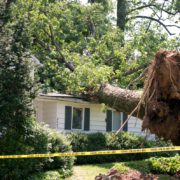How to Protect Your Home During Wildfire Season?
That title is a bit deceptive. In many parts of the U.S., wildfire season is year-round, and no part of the country is entirely immune. While wildfires in drought-prone areas like California, Arizona and Texas are most frequently in the news; no area of the country is entirely immune. That’s because the U.S. Department of Interior estimates that as many as 90% of wildfires in the U.S. are caused by humans; the other 10% are attributed to lightning strikes and lava. They can start because of an unattended campfire, burning trash that gets out of hand, a carelessly discarded cigarette, intentional acts of arson, or, in the case of the devastating 2003 San Diego County Cedar Fire, an inexperienced hunter who was lost in the bone-dry backcountry and lit a signal fire. You can’t do much to prevent fires started by the foolish, careless and crazy, but you can take several proactive steps to protect your home during wildfire season.
Create and Maintain Defensible Zones Around Your Property
All homeowners insurance covers damage by fire. But no amount of fire insurance can make up for losses like personal photographs, family pets or heirlooms. And, while nothing you do, no matter how diligent, can guarantee that your property and possessions will survive a wildfire, your odds are better if you create buffer zones between structures on your property and the grass, trees, shrubs surrounding them. You’ll also be helping firefighters to more easily defend your home. And, demonstrating that you’ve taken proactive steps may score you some points with your homeowner’s insurance carrier.
ReadyForWildfire.org recommends the following:
- Create a minimum 100 feet of defensible space consisting of two zones – Zone 1 is 30 feet out from buildings, decks and flammable structures, but this may vary by ordinance depending on where you live. Check with your county government or local fire department for specific requirements.
- In Zone 1 – Remove all dead vegetation including what has accumulated in rain gutters, on the roof, under porches and around the yard. You should also trim trees to keep branches at least 10 feet apart and away from roofs and chimneys; remove or prune flammable plants near windows; and move woodpiles into Zone 2.
- In Zone 2 – Keep grasses to a maximum of 4 inches and remove fallen leaves, pine needles, twigs, cones and small branches, although some jurisdictions allow them to accumulate to a depth of 3 inches.
ReadyForWildfire.org, also recommends creating the correct horizontal and vertical spacing in Zone 2 to reduce the spread of wildfire. This is determined by the type and size of the trees and shrubs as well as the slope of the land. Diagrams illustrating these concepts are available at their website.
Fire-Resistant Landscaping
In addition to maintaining your yard and surroundings, strategic planting can be a big help in resisting the spread of wildfire to your home. The U.S. Fire Administration and FEMA offer these tips:
- Check with your local nursery or county extension service to learn which plants are fire-resistant and right for your part of the country.
- Use hardscaping such as stone walls, pools and paths to create fire-safe zones.
- Create firebreaks by covering bare space with rock, mulch, flowerbeds and other ground cover.
- Select plants with high moisture content such as low-growing succulents for ground cover. Avoid anything with a high sap or resin content.
- Consider fire-resistant shrubbery such as hedging roses, sumac, bush honeysuckle and currant.
- Opt for hardwoods like maple, cherry and poplar, which are less flammable than conifers.
Design & Construction Precautions
Fire.CA.gov publishes a homeowner’s checklist pdf that includes these preventive design and construction recommendations:
- Enclose the underside of eaves, balconies and above-ground decks with fire resistant materials.
- Consider installing residential sprinklers (doing so can net you a nice discount on your homeowners’ insurance).
- Cover your chimney outlet and stovepipe with nonflammable screen with half-inch or smaller mesh.
Be Prepared for the Worst
Between January and July of 2014, there were nearly 30,000 wildfires that burned over 1 million acres across the country, according to the National Interagency Fire Center. Regardless of where you live, have an evacuation plan in the event of fire. You should also make sure your homeowners insurance coverage is up-to-date and can adequately replace structural and personal possession losses at today’s prices. You can compare coverage options and shop for homeowner’s insurance quotes here.

 EINSURANCE
EINSURANCE EINSURANCE
EINSURANCE  EINSURANCE
EINSURANCE  EINSURANCE
EINSURANCE